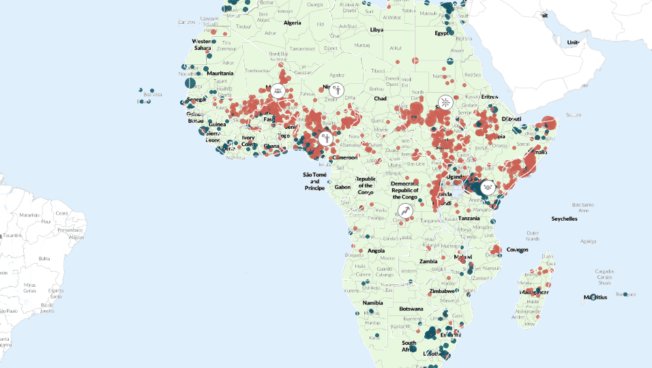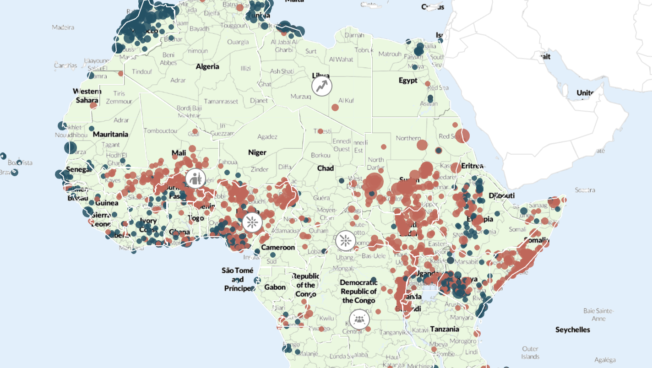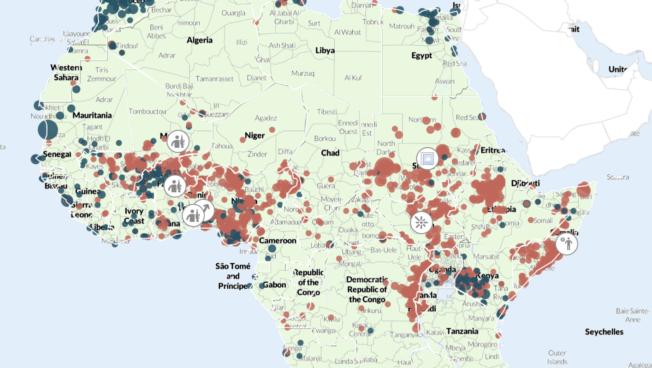Regional Overview
Africa
April 2025
Posted: 4 April 2025
In this Regional Overview covering March 2025
- Burkina Faso: JNIM increasingly turns to drone strikes
- Democratic Republic of the Congo: M23 and FARDC allies become increasingly active following the ceasefire agreement
- Ethiopia: Battles surge amid a Fano offensive in Amhara
- Nigeria: Military airstrikes against insurgents in Borno state increase
- South Sudan: The military responds to escalating violence with a surge in airstrikes
- Sudan: The SAF regains control of Khartoum from the RSF
Burkina Faso: JNIM increasingly turns to drone strikes
Last month, Jama’at Nusrat al-Islam wal-Muslimin (JNIM) carried out six drone strikes in Burkina Faso, reflecting the group’s increasing use of drones to conduct strikes against civilians, military forces, and the Volunteers for the Defense of the Homeland (VDP). The strikes often involved JNIM fastening IEDs to quadcopter drones. The insurgents dropped explosives on military positions in the Center East, Center North, East, and Sahel regions. JNIM began using these makeshift drones in September 2023 after dropping two IEDs by drone against Dan Na Ambassagou positions in Mali’s Bandiagara region. Since then, JNIM has carried out over a dozen attacks using drone explosives in Mali and Burkina Faso.
The growing use of drone warfare by state and non-state actors, including JNIM, the Azawad Liberation Front (FLA), and the Wagner Group, marks a shift from traditional guerrilla tactics to advanced warfare in the central Sahel. These groups use modified commercial drones for surveillance and reconnaissance as well as targeted strikes with drone-delivered explosives, including kamikaze drones.
Democratic Republic of the Congo: M23 and FARDC allies become increasingly active following the ceasefire agreement
After the Angola-led peace negotiations between the DRC and Rwanda broke down, Doha managed to broker a ceasefire between Rwandan President Paul Kagame and DRC President Félix Tshisekedi on 18 March. Following the ceasefire, violence related to the March 23 Movement (M23) rebellion did not decrease, but the Rwanda Defense Force (RDF) and Congolese military (FARDC) became less involved in the conflict. The RDF ceased direct operations, and the FARDC’s involvement in hostilities declined. The FARDC engaged in only 20% of the battles in North and South Kivu after the ceasefire compared to 66% prior to the agreement. Instead, the Wazalendo coalition — a loose association of militias aligned with the Congolese military that initially emerged as localized youth self-defense groups — took an increasing role in combating the M23 and armed groups allied to the rebellion. ACLED records over 110 battles involving Wazalendo militants last month, more than double the average over the past year and more than twice the number of battles involving the Congolese military in North and South Kivu last month. Several armed groups allied to the M23 also became increasingly active in March. Notably, the Twirwaneho and Ngumino militias played an increasingly active role as M23 allies, contesting numerous areas in the high plateau of South Kivu against FARDC-allied groups.
Ethiopia: Battles surge amid a Fano offensive in Amhara
In March, Fano militias announced the commencement of new coordinated operations in the Amhara region and the desire to merge several factions of the movement.1Borkena, “Wollo Fano Forces Reportedly Launch Major Offensive In Woldia Area,” 12 March 2025; Africa Intelligence, “Fano armed groups to announce merger in Amhara region,” 27 March 2025 The announcement prompted a surge in armed activity. ACLED records over 150 battles in Amhara last month, the most since the onset of the Fano insurgency in April 2023. The Fano, fragmented groups of armed youth generally recruited from the Amhara region, have been fighting against the federal military forces for areas understood to be homelands of the Amhara people.
The Ethiopian National Defense Force (ENDF) also confirmed the Fano operation, claiming that the campaign started under the command of General Migbe Haile, a Tigray Defense Forces (TDF) brigadier general.2Facebook @FDRE Defense Force, 21 March 2025; Addis Standard, “#NewsAlert: Ethiopian defense forces claim renewed Fano attempts to mount attacks ‘encouraged’, ‘coordinated’ by senior Tigrayan general in Amhara region ‘crushed’,” 21 March 2025 Haile was one of three generals dismissed by the interim regional administration of Tigray on 10 March after they were blamed for inciting violence, suggesting that he is interested in ousting the regional administration.3Addis Standard, “#NewsAlert: Ethiopian defense forces claim renewed Fano attempts to mount attacks ‘encouraged’, ‘coordinated’ by senior Tigrayan general in Amhara region ‘crushed’,” 21 March 2025 These maneuvers follow increasing speculation of a regional war between Eritrea and Ethiopia triggered by the former Ethiopian president, Mulatu Teshome Wirtu’s, accusation of rapprochement between the Eritrean government, some TDF generals, and factions of the Fano movement.4Mulatu Teshome Wirtu, “To avoid another conflict in the Horn of Africa, now is the time to act,” Aljazeera, 17 February 2025; Africa Center for Strategic Studies, “Rising Tensions in Tigray Risk Regional Conflict,” 26 March 2025; Africa Confidential, “Tigray’s political fight sounds alarm,” 21 March 2025 However, the lack of cohesion among Ethiopian political parties, Fano militias, and the Eritrean government, and their divergent interests, currently make the escalation of conflict between Eritrea and Ethiopia unlikely.
Nigeria: Military airstrikes against insurgents in Borno state increase
In March, Nigerian military forces intensified their aerial counterinsurgency operations as part of Operation Hadin Kai against Boko Haram and the Islamic State West Africa Province (ISWAP). While the counterinsurgency campaign also involved ground operations, ACLED records at least eight airstrike events, resulting in over 90 reported fatalities among militants. The intense airstrikes came after ISWAP overran a military base in Damboa Local Government Area (LGA) on 9 March, during which they captured materiels and destroyed other military equipment.
The use of air- and drone strikes is an integral component of the conflict in Borno state, especially as Boko Haram and ISWAP increasingly rely on the use of drones to drop explosives and conduct surveillance missions. ISWAP and Boko Haram militants employed weaponized drones in a multipronged and coordinated attack on a Nigerian army base in Wajiroko and a military outpost in Wulgo on 24 March, reportedly killing at least a dozen Cameroonian soldiers in the Multinational Joint Task Force.5Ahmed Kingimi and Amindeh Blaise Atabong, “Militants kill 16 on Nigerian army base, military outpost, security sources say,” Reuters, 26 March 2025 In the wake of the attack, Niger withdrew from the regional coalition to strengthen security around its oil assets,6Reuters, “Niger withdraws from Lake Chad military force,” 30 March 2025 which jihadist groups and rebels have increasingly targeted in 2025.
South Sudan: The military responds to escalating violence with a surge in airstrikes
In March, tensions escalated between President Salva Kiir and First Vice President Riek Machar, eroding any semblance of political stability in the world’s youngest nation. The rift deepened following accusations by the Sudan People’s Liberation Movement-In Opposition (SPLM-IO), headed by Machar, that government forces had systematically targeted and detained political and military figures affiliated with the opposition coalition in late February.7Human Rights Watch, “South Sudan: Opposition Leaders, Others, Detained,” 13 March 2025 By early March, clashes intensified between the South Sudanese Armed Forces (SSPDF) and the White Army militia, a predominantly Nuer armed group believed to be aligned with Machar. The intensification of fighting in Upper Nile State triggered mass displacement as over 50,000 civilians fled the violence.8Radio Tamazuj, “NPA says 50,000 people fleeing deadly conflict in Upper Nile,” 19 March 2025;
Barrons, “S.Sudan Clashes Displace 50,000 As Western Nations Offer To Mediate,” 18 March 2025 Government forces placed Machar and his wife, Interior Minister Angelina Teny, under house arrest on 26 March, a move that the SPLM-IO denounced as effectively dismantling the 2018 peace agreement that ended South Sudan’s civil war.9Wycliffe Muia and Ashley Lime, “VP’s arrest ends South Sudan peace deal, his party says,” BBC, 27 March 2025
In order to combat the White Army and Machar’s influence, the SSPDF relied on an increasing number of airstrikes with backing from the Ugandan military. While the use of air- or drone strikes in South Sudan has been rare since 2017 during the civil war, ACLED records a sharp increase in the number of airstrikes carried out by the SSPDF in March. Although some aerial bombardments targeted the SPLM-IO, half of the 14 airstrikes solely hit civilians. Some reports suggested the bombs from the airstrikes contained ethyl acetate, raising concerns about the use of chemical warfare.10Hereward Holland, “Airstrike kills at least 19 in South Sudan town, residents say,” Reuters, 17 March 2025; Radio Tamazuj, “UPDATED: Airstrike kills 21 civilians in Nasir,” 17 March 2025; Wycliffe Muia, “UN fears war as barrel bombs dropped in South Sudan,” BBC, 25 March 2025
Sudan: The SAF regains control of Khartoum from the RSF
As the war in Sudan is reaching its two-year point after breaking out in April 2023, the Sudanese Armed Forces (SAF) and allied armed groups regained control of Khartoum city on 21 March from the Rapid Support Forces (RSF). In March, fighting was concentrated in the downtown areas of Khartoum, culminating with the SAF retaking control over the presidential palace and government ministries. The fall of Khartoum represents a significant strategic victory for the SAF. It permits the SAF access to key areas, such as the airport, and links previously isolated SAF forces to operate more cohesively, which will be strategic as the military confronts the RSF in neighboring Omdurman.
The RSF had controlled large swathes of the capital since the war broke out in 2023, and its loss marks a significant reversal in fortunes between the two sides. The SAF offensive to retake Khartoum began in September 2024, when the military and allied armed groups closed in on the RSF-held positions in downtown Khartoum from the bordering al-Jazirah and White Nile states. The RSF publicly admitted their retreat from the city to Omdurman but said the move was a tactical decision and vowed to return.11Sudan Tribune, “Sudan RSF leader says Khartoum withdrawal tactical,” 30 March 2025
See More
See the Codebook and the User Guide for an overview of ACLED’s core methodology. For additional documentation, check the Knowledge Base. Region-specific methodology briefs can be accessed below.
Links:
For additional resources and in-depth updates on the latest political violence and protest trends, check our local observatories for Mozambique and Ethiopia, as well as our special Nigeria Election Violence Tracker project.







